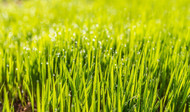What Grass Seed Do I Need?
Seed mixes can often a complicated subject, with many different varieties on the market it is difficult to know which mix will be the most suitable for your outdoor space. The first most important consideration is the quality of the seed, most cheaper seed mixes will be unreliable and unpredictable in terms of germination and quality or coverage of the finished article. Some of the cheaper seed mixes may even by contaminated with weeds or a harsh rye grass which offers more of a meadow appearance as opposed to a traditional lawn. All grass seed mixes supplied by Gardener Supplies have been sourced by reputable seed houses, it is all certificated and has over 27 years heritage of being used by gardeners across the UK.
Second consideration is the finished product, what do you want achieve from your lawn in terms of appearance and durability. For example the needs of a family garden where durability is of paramount importance will be very different to that of an ornate garden with very little trafficking. Seed mixes cover three main categories.
General Purpose Grass Seed Mix:
Ideal for a family or high -trafficked garden, a general purpose mix combines hard-wearing grasses and perennial ryegrass with a variety of fescues. This type of mix will withstand a lot of wear and tear from children or pets plus it is fast-growing so will need a lot of maintenance and regular mowing.
Luxury Lawn Grass Seed Mix:
These grasses will not tolerate a lot of wear and tear so would not be suitable for a family garden or areas that are highly trafficked. The mix will contain a fine leaved turf grasses, a mix of fescues resulting in a slow-growing lawn with a delicate appearance.
Shaded Lawns or Shady Areas:
Very few gardens in the UK will experience all round sunshine or be free of overhanging trees, fences and hedges, for those areas that experience shade there are specific grass seed mixes to overcome the lack of sunlight. They are normally a combination of fine leaved species and fescues as testing proves that these mixes normally require less light for photosynthesis.

